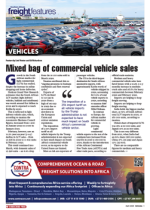SA Cargo has expanded its ro-ro services directly to the car terminals in Durban, Gqeberha and East London.“This strategic extension allows us to drive units directly through the terminal without unnecessary stops, streamlining the movement of vehicles. It enhances our control over the vehicle f low, both in terms of imports and exports, ensuring a smoother transition from vessel to yard,” says branch manager Denzil Reddy. “Furthermore, we have appointed dedicated service providers at both ends of the route to support this integrated approach, ensuring high service levels, reduced turnaround times, and improved operational efficiency,” he adds.SA Cargo is enhancing its ro-ro routes and strengthening collaboration with its service providers to overcome the challenge of peak volume congestion when import and export volumes surge simultaneously, when multiple vessels arrive.“These overlapping peak periods lead to space constraints within the terminals and yards, which can result in movement delays and operational bottlenecks. Coordinating vehicle f low becomes more complex, especially when there is limited f lexibility in vessel schedules and yard capacity,” Reddy told Freight News.“At SA Cargo, we are actively working on strategic solutions such as enhancing our ro-ro routes and strengthening collaboration with service providers to manage these challenges more effectively.”The vehicle mix is also changing as electric vehicle volumes gain traction. SA Cargo handled up to 6 000 units in March, “a clear indication that the demand for EVs is gaining traction in South Africa,” he says.Reddy believes that South African vehicle logistics capabilities remain world-class. “We are seeing strong performance indicators that align with international standards, particularly in the volume of vehicle exports, which has been on the rise. “Many global OEMs are choosing to export from South Africa, which highlights the country’s growing reputation as a reliable automotive manufacturing and export hub. This not only boosts confidence in our local logistics capabilities but also provides greater exposure for South Africa in the global supply chain.”Reddy sees the development of back-of-port operations situated close to the port terminals as a strategic solution to manage high volumes more effectively, providing overf low capacity, improving turnaround times, and allowing for a smoother f low of vehicles from vessel to yard. “By having these facilities close to the port, we can enhance coordination, reduce congestion within the terminal, and ultimately increase our ability to handle growing export volumes efficiently.”Additional capacity is needed as SA Cargo currently handles 600 000 to 700 000 units a year.“Our forecast indicates we could see this number rising to around 800 000 vehicles annually by 2025 and 2026. This anticipated growth is driven by the rising demand for South African-manufactured vehicles globally, increased OEM activity, and evolving consumer markets.”Part of that evolution is the growing number of Chinese-manufactured vehicles entering the South African market. “This surge in product variety not only ref lects shifting consumer preferences but also has a direct impact on logistics volumes.“It reinforces the need for agile, scalable logistics solutions to meet the demands of a fast-evolving automotive landscape,” he says. ER

